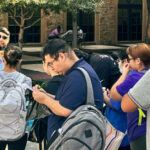The Quick Read:
– The Texas A&M System Board of Regents approved the naming of A&M-San Antonio’s Mays Center for Experiential Learning and Community Engagement. Lowry Mays, former chairman of the A&M Board of Regents and the Mays Family Foundation, donated $5 million toward the development of the center.
– In May, the Greater Texas Foundation announced the award of $1.4 million in scholarship support for early college high school graduates. This fall, the first cohort of nine early college high school students from three local districts will attend classes on campus.
– The College of Education and Human Development received a combined award of $850,000 for an innovative teaching model for Stewart Elementary.
– The campus’ Downtown Facility for Archives and Special Collections including the Daughters of the Republic of Texas (DRT) library holdings will open soon.
– President Matson announced $561,000 in scholarship awards, including the first cohort of Greehey scholars and a full-ride Toyota scholar.
Missed Convocation? Read other highlights:
Faculty and staff greeted each other with excitement for convocation Aug. 23 to hear from university leaders.
Convocation is very much like a state-of-the-union address where the president, provost, faculty senate and staff council cover key initiatives and forecast the year ahead. This year, University President Cynthia Teniente-Matson took the podium and said she will continue to focus on managed growth and “healthy and constructive change.”
Matson announced that after an 18-month planning period, the university adopted a new strategic plan to accommodate continuing academic growth.
“Strategic enrollment growth is vital to the future of our university and we’re building the model in which we can sustain our own growth over time,” Matson said, addressing a full auditorium of faculty and staff.
For now, student enrollment is growing at about 1,000 students per academic year. The projected student enrollment for fall 2017 is 6,627, about a 21 percent increase from last fall. Matson said the university is not suited to accommodate more.
“We do not have the physical infrastructure and organizational capacity to grow much beyond that,” Matson said.
Last semester, in a message from the president, Matson announced the State of Texas Appropriations Bill contained a 10 percent reduction in state revenue for A&M-San Antonio.
“I am working with the chancellor and others to maintain our special line item funding as we grow forward,” Matson said. “It will be challenging to lose all special item funding in one swoop.”
“Until we reach at least 6,000 full-time equivalents, and we’re about a little over 50 percent there, I will be personally working with the president’s cabinet and the university resources Commission to chart a course that leads us through this fiscal situation,” she said.
Matson told faculty and staff that she is working on building a data-driven culture and using data analytics to support how to think and make decisions about the future of A&M-San Antonio. The President’s Cabinet is “laser focused,” she said.
“We cannot grow our way out of a budget reduction and we can not cut our way to excellence,” Matson said. “We still need state support for a few more years and continued system support to continue to grow.”
In addition, the Science and Technology building is on schedule to open fall 2018 and the total project cost in under budget.
Provost Michael O’Brien and Chief Financial Officer Bill Spindle will continue to focus on additional spaces to support future programs in engineering technology and education.
“We are on track for one or more new buildings per year in line with our master plan,” Matson said.
Earlier this month, in consultation with Chancellor Sharp, the Board of Regents approved programming and planning funds for Phase One of the next academic building.
Two other groups were recognized at convocation for their achievements, Staff Council led by Art Olague and Faculty Senate led by Dr. Amy Porter. President Matson said she relies on both advisory groups for their leadership and agenda setting.
Last academic year, Faculty Senate increased the number of senators by departments not colleges, increased senator terms to three years and president terms to two years.
Staff council President Arturo Olague, director of recreational sports, said he hopes to effectively communicate between staff members and advocate for their needs.
In an effort to help out the A&M-San Antonio community, the staff council conducted a Jaguar Supply Drive. About 200 pounds of school supplies were donated for students and their families.
During Welcome Week, students in need of supplies can stop by the information booths to pick up school supplies. Extra donations will be donated to General’s Store.






